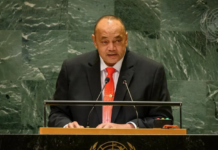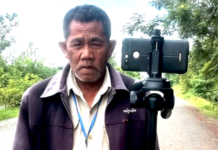
Aotearoa New Zealand coalition government leaders have rejected allegations they are degrading tino rangatiratanga, saying the proposed Treaty Principles Bill will not “delegitimise” Māori.
The criticism was levelled by protesters at the Waitangi Treaty Grounds today.
The leaders of National, ACT and NZ First faced a confronting reception, with the crowd booing NZ First’s Winston Peters and drowning out ACT’s David Seymour.
- READ MORE: Waitangi Day 2024: All the speeches and action from the Treaty Grounds on February 5
- In pictures: Government face raucous challenge at Waitangi
- Tame Iti brings Haki Ātea to Waitangi
Waitangi highlights. Video: RNZ News
But Prime Minister Christopher Luxon said there was “genuinely a sense of unity” and asked people to look beyond the “drama” of the protests and find common ground.
Ahead of the government’s arrival at the treaty grounds, veteran activist Tāme Iti led a hīkoi to the meeting house. The crowd carried white flags and chanted “honour Te Tiriti”.

A pōwhiri followed, with the biggest challenge reserved for Seymour, the leader of the ACT party and main proponent of the Treaty Principles Bill.
He faced a kāhui (group) of kaiwero, while Peters and Prime Minister Luxon were each challenged by one kaiwero.
Seymour then had his speech drowned out with a waiata before a protester walked onto the ātea and was stopped by security.
Seymour called for his opponents to “start talking about ideas and stop attacking people”.


‘Get some manners’
Peters was booed during his speech but quickly fired back.
“You tell me whoever said we’re getting rid of the Treaty of Waitangi. Stop the crap,” he said.
“Get some manners . . . get an education.”

Among the protesters was Eru Kingi-Kapa, who told RNZ the government’s kōrero was degrading to the tino rangatiratanga of te ao Māori.
Seymour knocked back the allegations, saying ACT had a “long history” of allowing people to self-determine.
“We believe in tino rangatiratanga, perhaps more so than anyone.”
The coalition was devolving decision-making power to Māori, and it was the previous Labour government that “centralised everything”, such as Te Pūkenga, taking power away from Māori, he said.
Seymour described the pōwhiri as “pretty fiery”, but said, “I give as good as I get”.
Ahead of the government’s arrival at the treaty grounds, veteran activist Tāme Iti led a hīkoi to the meeting house. The crowd carried white flags and chanted “honour Te Tiriti”.
IN PICTURES | Politicians from National, NZ First and ACT have been welcomed onto Waitangi Marae – with the fiercest challenge reserved for David Seymour.
Here are some of the best moments caught on camera.
📷 RNZ / Angus Dreaver
🔗 https://t.co/vON5JZLvW2 pic.twitter.com/viLoaTpFSk— RNZ Te Ao Māori (@RNZTeAoMaori) February 5, 2024
‘Opening up a debate’
NZ First MP Shane Jones also rejected the allegations the government and the Treaty Principles Bill were degrading tino rangatiratanga.
“I don’t believe anything our government is doing is delegitimising a personal choice many people make to be Māori,” he said.
“If you choose to accentuate that part of your whakapapa, [you’re] entitled to do that.”
Jones said the government was funding wānanga and marae throughout the country: “None of that delegitimises Māori.”
However, the government was “opening up a debate” on the principles of the Treaty and how they were applied in New Zealand’s increasingly multicultural society, he said.
“We need to ensure, as this debate goes forward, we have a long-term view to the best interests of all Kiwis.”
Jones said he would take an active role in that debate.
He said some of the protesters were “unnecessarily rude”, but he understood where they were coming from.
“Young people . . . I was young once. Out in the hot sun, you can get carried away.”

National won’t support Treaty Principles Bill
Luxon used his speech to reflect on Aotearoa’s history, before talking about his vision for Aotearoa in 2040.
The promises of the Treaty were not upheld, he said.
“Every nation’s past isn’t perfect. But no other country has attempted to right its wrongs.”
Speaking to media, he said National had “no intention, no commitment” to support ACT’s Treaty Principles Bill beyond the first reading.
There would also no referendum on the Treaty of Waitangi, he said.
This article is republished under a community partnership agreement with RNZ.















































